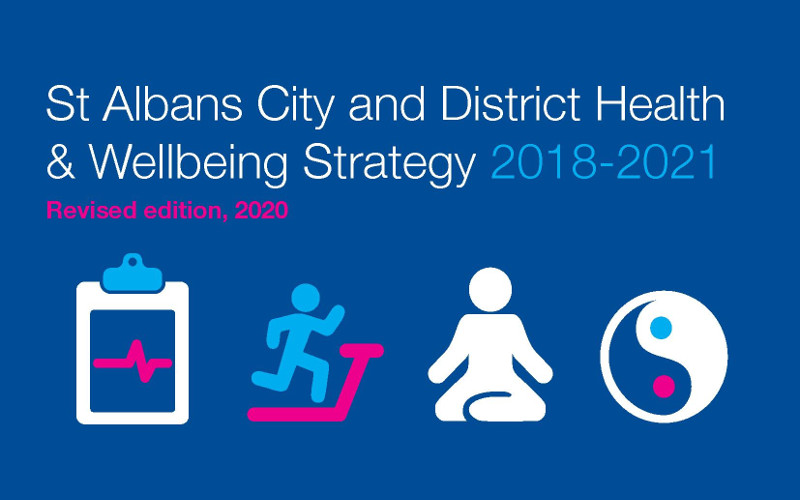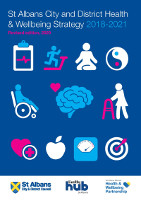
Health and wellbeing strategy for St Albans District is updated
A strategy for improving the health and wellbeing of people in the St Albans District has been updated to take account of new projects and initiatives.
One major development since the strategy was launched two years ago is the Healthy Hub.
The Healthy Hub, funded by Hertfordshire County Council, opened last year and is located within the offices of St Albans City and District Council.
 A host of groups based there offer residents help and information about boosting their physical and mental health.
A host of groups based there offer residents help and information about boosting their physical and mental health.
Advice on weight loss, healthy eating, addiction and other issues is available from a Mind In Mid Herts, Age UK, the Living Room and many other organisations.
Free mini health MOTs, provided by leisure contractor 1Life, were started this month in another new initiative.
The strategy – the first of its kind – was launched two years ago by the St Albans District Health and Wellbeing Partnership. The Partnership is made up of the Council and numerous other statutory health and voluntary organisations including Herts Valleys Clinical Commissioning Group, West Hertfordshire Hospitals NHS Trust and St Albans and Harpenden Patient Group.
Its overarching aims are to improve health and wellbeing by encouraging healthy lifestyles and reducing health inequalities. Equal weight is given to physical and mental health while prevention is one of the key themes.
Work on the revised strategy was undertaken by Council officers and volunteers representing the Public Health Working Group. It was formally approved by the Partnership at its meeting on Tuesday 28 January.
The 20-page document is now available to view on the Council’s website and paper copies are available on request.
It contains the latest data about health in the District showing, for example, that 48.9% of the District’s residents are overweight.
The strategy also details the Partnership’s long-term goals and the different actions that are being taken to achieve them.
For example, the Partnership is working towards the goal of making the District dementia-friendly. Actions will include training sessions to increase the number of dementia friends and the promotion of services for dementia sufferers and their carers.
Another goal is to reduce social isolation and loneliness. Actions to achieve this include using the Healthy Hub’s online service to raise awareness of the many activities and community groups that can help alleviate such feelings.
Councillor Robert Donald, the Chair of the Partnership and the Public Health Working Group, said:
A tremendous amount of hard work has gone into revising this comprehensive strategy for improving the District’s physical and mental health.
Together with our partners, we have updated the document to reflect the actions that we have already undertaken to achieve our goals as well as the many new initiatives that are planned.
The document is an outstanding example of the great things that can be achieved by professional clinicians, NHS Trusts, local authorities and voluntary medical and care organisations working together in a co-ordinated and effective way.
While we live in a relatively healthy District with activity levels and rates of early death from cancer and heart disease better than national averages, we are not complacent and know improvements can be made.
For example, the number of adults overweight and obese has only fallen by less than 1% year on year in the latest annual figures available to 48.9% and in year six children it has actually increased by 0.2% to 21.4%. Mental health and reversing the current rise in suicides locally are also both areas of concern addressed in the new strategy where the Partnership want to see improvements.
Moreover, we also need to prepare for future trends such as the consequences of an ageing population and what that means in terms of demand for particular services. This includes diabetes and dementia support and preventing the number of older residents feeling isolated and lonely.
Our District has already been at the forefront of pioneering new models of non-medical care and support of people with some physical and mental health conditions. For example, the use of social prescribing with ‘navigators’ in some GP surgeries signposting patients to appropriate activities, therapies or counselling services and the Council’s own Healthy Hub. These innovative pilot schemes need to continue so they can become embedded in all our GP practices.
I would urge anyone interested in how we are shaping up to meet these health and wellbeing challenges to look at our revised strategy. The document is easy to read and full of interesting health information about St Albans District and what we are doing to try to promote healthier lifestyles locally.
The strategy can be viewed on the link below.
Councillor contact:
Councillor Robert Donald, Chair of St Albans District Health and Wellbeing Partnership: cllr.r.donald@stalbans.gov.uk; 01727 841647.
Contact for the media:
John McJannet, Principal Communications Officer: 01727 819533, john.mcjannet@stalbans.gov.uk.
